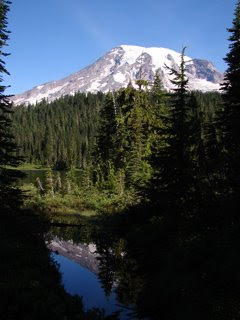
For me this—meaning the badlands of the national park—is a sanctuary space, a place to reconnect with a very long line of creation, and to re-create. Having been to somewhere north of 50 national parks and monuments, this remains my favorite. Not the most spectacular in vistas and inclines, not the most enriching in historical and cultural exhibits, and certainly not the largest since the southern unit where I wander is about the size of the city of Chicago. But in freedom of access, striking topography, concentration of wildlife, and harmony of light and form (photographically speaking), this park stands apart.
 Imagine a rumpled bed sheet and you have an idea of this eccentric land, creased and furrowed into haystack hillocks, knife-edged ridges, and capstone buttes and outcroppings. This park measures something like 20 miles by 10 miles and within that space you can encounter bison, elk, mule deer, whitetail deer, coyotes, badgers, pronghorns, wild turkeys, and loads of prairie dogs. So a lot to offer, depending on what you are looking for.
Imagine a rumpled bed sheet and you have an idea of this eccentric land, creased and furrowed into haystack hillocks, knife-edged ridges, and capstone buttes and outcroppings. This park measures something like 20 miles by 10 miles and within that space you can encounter bison, elk, mule deer, whitetail deer, coyotes, badgers, pronghorns, wild turkeys, and loads of prairie dogs. So a lot to offer, depending on what you are looking for.
We are now closing on 4,000 miles and four weeks of travel, and out of that we have spent 12 days in the cab of a Ford F250 pickup, with a 28-foot fifth wheel trailer attached, rolling through the northern plains prairie, Rockies and Cascades, the Puget Sound, the orchard lands and vineyards of eastern Washington, and the rangeland of western Dakotas.

We have acclimated ourselves to the road and the anticipation that tomorrow or the next day delivers a different perspective. Our trip has been about reconnection (friends and family in Omak, Seattle and Bozeman), prayer and parting (my wife’s mother in hospice in Walla Walla), and chemotherapy for our dog Suki at vet clinics in Montana, North Dakota, and Seattle (we may have a guide book out soon). Two adults, a college student and two white dogs adapting to the quirks of trailer life, and a shifting panorama, and each other’s moods and tastes (the college student has cut back on the Cheez-Its, and is now overdosing on anime clips using the campground wifi service).
Last photo was last night of the Little Missouri River. And the end of the road tomorrow. We have a few rocks for the garden, a case of Walla Walla wine, and hundreds of pics, but the really precious acquisition is the shared experience. Even at $4.21 a gallon (Washington) it was worth every mile.















